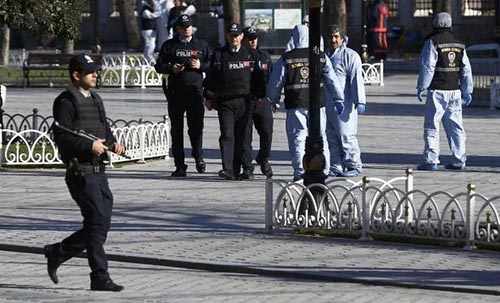Sultanahmet: Istanbul's tourist hub under attack
Tuesday's deadly suicide attack in Istanbul's tourist hub of Sultanahmet took place just a stone's throw from the city's most visited sites, the Blue Mosque and the Hagia Sophia church.
Situated on the European side of Istanbul, the historic quarter is listed as a world heritage site by the UN's cultural organisation UNESCO.
Sultanahmet Square, an ancient arena turned city park, was built in the second century AD by Roman Emperor Septimius Severus and then expanded in 324 AD by Constantine the Great.
It was the scene of games and riots through 500 years of Ottoman Empire history.
It is nowadays encircled by giant motorcoaches which ferry masses of tourists to Istanbul's main sites.
Most of the 10 people killed in Tuesday's attack were German.
The Syrian suicide bomber blew himself up by the Obelisk of Theodosius, one of the city's most eye-catching sites.
A granite monument from ancient Egypt, the Obelisk was re-erected by the Roman Emperor Theodosius in 390 AD.
The Obelisk stands just outside the Blue Mosque which sits on the other side of the square from Istanbul's other main tourist site, the Hagia Sophia church.
Both grandiose edifices of Christianity and Islam reflect the diverse heritage of a city at the meeting point of Europe and Asia.
Built in the 6th century, Hagia Sophia, which means Holy Wisdom in Greek, was converted to a mosque in 1453 when the Ottomans conquered what was then called Constantinople.
After the Ottoman Empire crumbled and modern secular Turkey was founded on its ruins, the mosque was transformed into a museum in 1935.
The edifice, a masterpiece of Byzantine architecture, features an immense dome supported by huge pillars, its walls sheathed with marble and decorated with mosaics.
After the city fell to the armies of Sultan Mehmet II The Conqueror, four minarets were added to the structure and the interior was decorated with Islamic art.
The Sultanahmet Mosque, better known as the Blue Mosque for its distinctive tilework, was built in the early 17th century by Sultan Ahmet I to compete with the grandeur of Hagia Sophia.
The mosque is one of Istanbul's largest, its six minarets dominating the skyline of the Golden Horn's southern shore.
The Sultanahmet area is the home to many of Istanbul's other popular tourist attractions such as the Topkapi Palace, the underground Cistern Basilica and the Archaeological Museum.
Photo: Police secure the area after an explosion near the Ottoman-era Sultanahmet mosque, known as the Blue mosque in Istanbul (Reuters)
Related Posts

